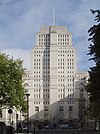User:Jim62sch/London School of Hygiene & Tropical Medicine
| London School of Hygiene & Tropical Medicine | |
| Established | 1899 (1924 Adopted current name) |
| Director | Professor Sir Andrew Haines |
| Location | London, United Kingdom |
| Students | 2,256 total (1,352 distance learning) |
| Staff | 704 (full-time equivalent) |
| Member of | University of London |

The London School of Hygiene & Tropical Medicine (LSHTM or the "London School") is a European postgraduate institution that specializes in public health and tropical medicine issues, and is associated with the World Health Organization (WHO).[1] The London School is internationally recognized center for its work in the fields of public health, international health and tropical medicine.
The stated mission of the School is to contribute to the improvement of health worldwide, to offer postgraduate teaching and advanced training in national and international public health and tropical medicine, and to develop policies aimed at improving practice in these areas.
History
[edit]The School was founded in 1899 by Sir Patrick Manson as the London School of Tropical Medicine and was located on the London Docks. Manson was a physician who worked in the Far East in the 1860s-1880s, where he encountered tropical diseases and was frustrated by his lack of knowledge. On his return to London, among other roles, he was appointed Medical Advisor to the Colonial Office. He believed that doctors should be trained in tropical medicine, to treat the many British citizens who were dying of tropical diseases that could have been treated if colonial doctors knew more about these diseases. The original School was established as part of the Seamen's Hospital Society, it has its origins in the hospital ships which were docked on the Thames at Greenwich.
In 1920 the School moved, with the Hospital for Tropical Diseases, to Endsleigh Gardens in central London, taking over a former hotel which had been used as a hospital for officers during the First World War. In 1921 the Athlone Committee recommended the creation of an institute of state medicine, which built on a proposal by the Rockefeller Foundation to develop a London-based institution that would lead the world in the promotion of public health and tropical medicine. This enlarged School, now named the London School of Hygiene & Tropical Medicine was granted its Royal Charter in 1924.
The main School building is on Keppel Street in Bloomsbury, London. This building was opened in 1929 by the Prince of Wales. The purchase of the site and the cost of a new building was made possible through a generous gift of $2 million from the Rockefeller Foundation. A competition to design the new School building was held involving five architects, all experienced in laboratory design and construction. This was won by Morley Horder and Verner Rees.
Programs
[edit]Further reading
[edit]- Lise Wilkinson and Anne Hardy, Prevention and cure: the London School of Hygiene & Tropical Medicine: a 20th century quest for global public health, Kegan Paul Limited, 2001, ISBN 0-7103-0624-5
See also
[edit]Notes and References
[edit]External links
[edit]- London School of Hygiene & Tropical Medicine website
- Chronology
- The History of Higher Education in Bloomsbury and Westminster London School of Hygiene & Tropical Medicine entry
[[Category:London School of Hygiene and Tropical Medicine|*]]
[[Category:University of London]]
[[Category:Schools of Medicine in the United Kingdom]]
[[Category:Health in London]]
[[Category:Camden]]

